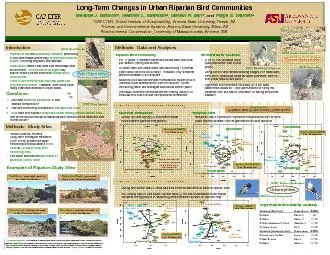

Results Riparian Bird Community 0500051015 050005 NMDS1NMDS2ABTOAMGOAMKEANHUBEKIBEWRBGGNBLPHBRSPBTGNBTSPCACWCBTHCOHACOHUCOYEDEJUEUSTGAQUGIFLGIWOGTGRHOFIHOSPHOWRINDOLBWOLEGOLISPLOSHMAWRMODON ID: 826352
Download Pdf The PPT/PDF document "Results: Environmental Variables" is the property of its rightful owner. Permission is granted to download and print the materials on this web site for personal, non-commercial use only, and to display it on your personal computer provided you do not modify the materials and that you retain all copyright notices contained in the materials. By downloading content from our website, you accept the terms of this agreement.
Results: Environmental VariablesResults
Results: Environmental VariablesResults: Riparian Bird Community-0.50.00.51.01.5-0.50.00.5NMDS1NMDS2ABTOAMGOAMKEANHUBEKIBEWRBGGNBLPHBRSPBTGNBTSPCACWCBTHCOHACOHUCOYEDEJUEUSTGAQUGIFLGIWOGTGRHOFIHOSPHOWRINDOLBWOLEGOLISPLOSHMAWRMODONOCANOFLNOMOOCWAPHAIRCKIRNSAROPIROWRRWBLSAPHSOSPSSHAVERDWCSPWEMEYEWAYRWAMarsh_SWater_SHighVeg_SCC_SImperv_LBare_LWater_L-1.0-0.50.00.51.0-0.50.00.51.0NMDS1NMDS2ABTOAMGOANHUBEKIBEWRBLPHBTGNBTSPCACWCBTHCOHACOHUCOYEDEJUEUSTGAQUGIWOGTGRHOFIHOSPLBWOLEGOMAWRMODONOCANOFLNOMOOCWAPHAIRCKIROPIRWBLSAPHSOSPSSHAVERDWCSPWEMEYEWAYRWAbc-0.50.00.5-0.4-0.20.00.20.40.6NMDS1NMDS2ABTOANHUATFLBCHUBEVIBEWRBGGNBHCOBLPHBRBLBRSPBTGNBTSPBTYWBUORCACWCBTHCHSPCOHUCORACOYEEUSTGAQUGIFLGIWOGRROGTGRGTTOHOFIHOSPINDOLASPLAZBLBWOLEGOLISPLUWAMAWRMGWAMODONOCANOFLNOMOOCWAPHAIRCKIRWBLSAPHSOSPVEFLVERDWCSPWEKIWIWAWWDOYEWAYHBLYRWAMarsh_SHighVeg_SCC_SImperv_LBare_LWater_L-1.0-0.50.00.51.0-0.50.00.51.0NMDS1NMDS2ABTOANHUATFLBCHUBEVIBEWRBHCOBLPHBRSPbcMethods: Data and AnalysesMethods: Study Sites Introduction Are there seasonal differences species composition?Has bird community composition changed over time3.Howdoes bird species composition differ among various riparian sitesand which environmental variables explain variation of the sites and bird communities?Temporal ShiftSpring and Winter NMDS show how bird communities differ at various riparian sites.Six (Spring NMDS) and seven (Winter NMDS) site and landscape environmental variables are significant in explaining environmental variation of riparian sites. Variables(Sitelevel)GraphNameNMDSMarshMarsh_SWWaterWater_SSHighVegetation(�1.5m)HighVeg_SSCanopyCoverCC_SSVariables(Landscapelevel)GraphnameNMDSSurfaceImperv_LSBareGroundBare_LSWaterWater_LSCentral ArizonaPhoenixLong-Term Ecological Research(CAP LTER) project has been monitoring bird populations 12 riparian long-term monitoring sites.Site water features are ephemeral or perennial, loticor lentic. Examples of Riparian Study SitesRetention Basin, drain in an urban landscapeCave Creek, ephemeral wash in the SonoranDesertSalt River, perennial reach in an urban landscapeANHU: Annas HummingbirdSOSP: Song SparrowGRRO: Greater Road RunnerBLPH: Black PhoebeWater SpecialistsUrbanophilesDesert SpecialistsWater SpecialistsDesert SpecialistsUrbanophilesNew River, ephemeral wash in an urban landscapeDesert SpecialistsWater SpecialistsUrbanophilesNOMO: Northern MockingbirdGeneralistsUrbanophilesWater SpecialistsDesert Specialists-1.0-0.50.00.51.0-0.50.00.51.0NMDS1NMDS2ABTOAMGOAMKEANHUATFLBCHUBEKIBEVIBEWRBGGNBHCOBLPHBRBLBRSPBTGNBTSPBTYWBUORBUSHCACWCANTCAVICBTHCHSPCOHACOHUCORACOYEDEJUEUSTGAQUGIFLGIWOGRROGTTOHOFIHOSPHOWRLASPLAZBLBWOLEGOLISPLOSHLUWAMAWRMGWAMODONOCANOFLNOMOOCWAPHAIRCKIRFLBRNSAROPIROWRRWBLSAPHSOSPSPTOSSHAVEFLVERDWCSPWEKIWEMEWIWAWWDOYEWAYHBLYRWAmigrantssuchwarblersvireoscontributespringbirdcommunitySeasonal NMDSk=3, Stress=0.079Winter Shift NMDSk=3, Stress=0.144Spring Shift NMDSk=2, Stress=0.184Spring NMDSk=2, Stress=0.064Winter NMDSk=2, Stress=0.088CACW: Cactus WrenTemporal NMDS ordinations indicate a compositional shift to more urban tolerant species such as generalists for both seasons.Significant Environmental VariablesRiparian zonesare biodiversity hotspots, particularly in arid landscapes where they provide resourcesfor , including migratory bird species.Urbanization affects site-level and landscape-level environment. Environmental changes maylead to riparian zones that foster altered biotic communities.Shifts in bird communities may take place overlong temporal scales. However, such shifts have rarely been documented in urban areas.Environmental VariablesIn 2013site variables werequantified within 40m of birdUsing ArcGISand remote sensing images (1m resolution) from 2010, landscape variables were quantified within a 2km buffer around bird points.Significant environmental variables (p) were determined based on 1,000 permutations of fitting the variables onto the NMDS ordination for spring and winter Riparian Bird CommunityFor 11 years, 3 different observers visited each site once per season (spring and winter).All birds seen and heard were recorded during 15-minute open-radius point count surveys. However, only landbirdswere considered in our analysis.Seasonal bird abundance was the seasonal maximum # of individuals per species within 40m of the point. When combining years, we averaged abundance across years.We used NonmetricMultidimensional Scaling (NMDS) to evaluate bird communities compositional differences.Water SpecialistsBTSP: Black-throated SparrowTime Frames:(a) 2002 & 2004, (b) 2007 & 2008, (c) 2011 & 2012Winter (W) and Spring (S) bird communities have different species composition.Acknowledgments: This material is based upon work supported by the National Science Foundation under grant no. BCS-1026865. Thanks to an incredible number of people who participated in data collection, data entry, and logistics for this project. Thanks to Maricopa County Flood Control District, Fort McDowell Yavapai Nation , City of Phoenix, and Arizona Department of Transportation for site access. Photo Credits: Mélanie J. Banville